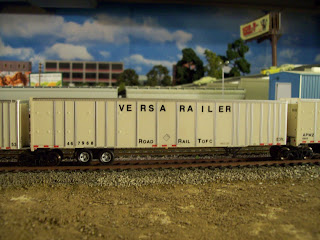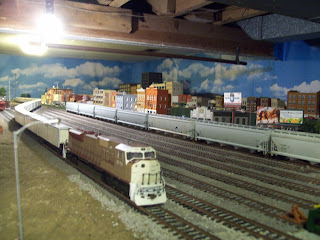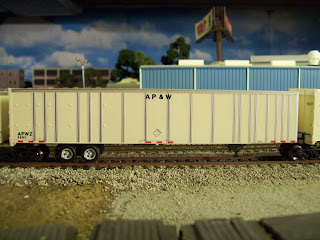Bob says goodbye to the guys at the end of the day. He's on vacation next week, and he'll be hitting the road -on his custom chopper!
Jake and Briggs are busy dealing with an engine problem on one of the company trucks. Hopefully, it's a minor issue; otherwise they'll have to have it towed.
They are trying to move an excavator to another yard. These machines are helpful in digging drainage ditches and cleaning up after storms. And with the bucket replaced with a grapple attachment, they are also good for tie removal. Of course, if the tractor needs towing, they'll have to detach the trailer; otherwise the towing fees will be too great!
Speaking of tie removal, several carloads of removed ties sit in the yard, as the annual maintenance of the rail lines continue. While concrete ties are popular out West, along the eastern half of the country wood ties still reign supreme, due to the lower speeds that come with traveling through densely populated areas.
And speaking of concrete: an empty Blue Circle Cement hopper sits in the yard, after being unloaded at the local Ready-Mix dealer. The small, two-bay design is well-suited for hauling cement, which is a dense, heavy powder.
Sunday, September 24, 2017
Sunday, September 17, 2017
TOWN LIFE PT25; TRUCKS
With the fall season approaching, truck traffic continues to build...
A mini convoy of reefer trucks rolls down County Lane. The semi is headed to the dairy plant, while the two smaller trucks are both headed to the supermarket.
A tanker from Flying Eagle Transport rolls through.
A brand-new Volvo VNL760 pulls a HUB Group 53' container into town, headed for the warehouses. How new is the tractor? Volvo just introduced the re-designed VNL-Series this past April!
Another brand-new Volvo, this time a VNR300, rolls in with a 45' box trailer. The internet distributor is doing brisk business in fall merchandise! Like the re-designed VNL's, the VNR-Series was also introduced this past spring by Volvo. This new truck replaces the long-time local runner, the old, red Ford LNT 9000, finally retired after three decades of service.
A mini convoy of reefer trucks rolls down County Lane. The semi is headed to the dairy plant, while the two smaller trucks are both headed to the supermarket.
A tanker from Flying Eagle Transport rolls through.
A brand-new Volvo VNL760 pulls a HUB Group 53' container into town, headed for the warehouses. How new is the tractor? Volvo just introduced the re-designed VNL-Series this past April!
Another brand-new Volvo, this time a VNR300, rolls in with a 45' box trailer. The internet distributor is doing brisk business in fall merchandise! Like the re-designed VNL's, the VNR-Series was also introduced this past spring by Volvo. This new truck replaces the long-time local runner, the old, red Ford LNT 9000, finally retired after three decades of service.
Sunday, September 10, 2017
ROADRAILERS PT2
Last week, we saw the arrival of a RoadRailer train. Now the rest of the train...
Another 53' plate-wall unit, this time with a AAR-compliant road number and "VERSA-RAILER" lettering. As the lettering states, this Roadrailer can be used in all three phases: road, rail, or TOFC (Trailer On FlatCar); note that it has lifting-rails on the sides above the wheels and landing gear, to facilitate pick-up by a straddle crane for loading on a flatcar or spine car. This was an attempt to increase the appeal of RoadRailers and expand their use beyond strict unit-train service.
A 53' refrigerator RoadRailer. Alliance Shippers dabbled with Roadrailers, as did a pair of trucking companies. Note the arrows showing the lifting points along the side.
Another "VERSA-RAILER", this time a reefer unit. Note, however, that the road number is, once again, non-AAR compliant!
Another plate-wall unit, this time with ASCZ reporting marks and a large "53' x102"" on the side, denoting the trailer size. These units were leased to UPS for use in select routes out of Chicago, including to Atlanta and New York City. Note the UPS-style rims.
There are a a few NS TripleCrown RoadRailers in the train as well.
A trio of Swift RoadRailers round out the train. Schneider also tried Roadrailers as well, mostly on the West Coast. The concept has been tried out by several railroads over the years, since the 80's. The main issue was -and still is- the fact that RoadRailers are heavier than conventional trailers, which lowers the load capacity. Plus most customers don't ship 75-125 trailers at once -the ideal size for a RoadRailer train. The final nail in the coffin is the embrace of the 53' domestic container; it can be double-stacked for maximum efficiency, unlike trailers which can only be loaded one at a time. TripleCrown has acquired the equipment of other companies as they have given up on RoadRailers, but even they are shrinking; by this Thanksgiving RoadRailer service to Toronto will be ended. The AP&W's own RoadRailer service is limited to the two routes out of Chicago, and both may soon be discontinued as well.
Another 53' plate-wall unit, this time with a AAR-compliant road number and "VERSA-RAILER" lettering. As the lettering states, this Roadrailer can be used in all three phases: road, rail, or TOFC (Trailer On FlatCar); note that it has lifting-rails on the sides above the wheels and landing gear, to facilitate pick-up by a straddle crane for loading on a flatcar or spine car. This was an attempt to increase the appeal of RoadRailers and expand their use beyond strict unit-train service.
A 53' refrigerator RoadRailer. Alliance Shippers dabbled with Roadrailers, as did a pair of trucking companies. Note the arrows showing the lifting points along the side.
Another "VERSA-RAILER", this time a reefer unit. Note, however, that the road number is, once again, non-AAR compliant!
Another plate-wall unit, this time with ASCZ reporting marks and a large "53' x102"" on the side, denoting the trailer size. These units were leased to UPS for use in select routes out of Chicago, including to Atlanta and New York City. Note the UPS-style rims.
There are a a few NS TripleCrown RoadRailers in the train as well.
A trio of Swift RoadRailers round out the train. Schneider also tried Roadrailers as well, mostly on the West Coast. The concept has been tried out by several railroads over the years, since the 80's. The main issue was -and still is- the fact that RoadRailers are heavier than conventional trailers, which lowers the load capacity. Plus most customers don't ship 75-125 trailers at once -the ideal size for a RoadRailer train. The final nail in the coffin is the embrace of the 53' domestic container; it can be double-stacked for maximum efficiency, unlike trailers which can only be loaded one at a time. TripleCrown has acquired the equipment of other companies as they have given up on RoadRailers, but even they are shrinking; by this Thanksgiving RoadRailer service to Toronto will be ended. The AP&W's own RoadRailer service is limited to the two routes out of Chicago, and both may soon be discontinued as well.
Sunday, September 3, 2017
ROADRAILERS, PT1
A train of RoadRailers rolls through Hillsdale...
5115, an ex-Conrail SD80MAC, leads the train through Hillsdale Yard. There are several types of RoadRailers as well as multiple paint schemes in this train; let's take a look...
The predominant type of RoadRailer in the train is the plate-wall version, seen here. This is the original lettering scheme for the AP&W's units: however, note that the road number is not AAR standard; there should be a "46" prefix, denoting that the trailer is a 53' RoadRailer unit.
This is another variant of the AP&W scheme; conspicuity striping and a "53'x102"" label on the side. Note, however, that the "APWZ" marks are absent, and the road number is still non-standard.
The "APWZ" marks are back, with a different striping pattern, but still, the non-standard road number.
A variation; a smooth-sided RoadRailer. This is actually an insulated unit. Note the grey underframe, 2-hole Budd wheels (versus the standard 5-hole), and plenty of conspicuity striping -even up the ends and at the top of the trailer! It also has both the Wabash logo at the rear, and a "53" at the front, indicating trailer length -but no reporting marks or number on the sides (government regulators will have a field day!).
Another insulated RoadRailer is this CIE unit. While it doesn't have striping, it does at least have reporting marks and an AAR-Compliant road number.
More styles -including refrigerated units- will be seen next week.
5115, an ex-Conrail SD80MAC, leads the train through Hillsdale Yard. There are several types of RoadRailers as well as multiple paint schemes in this train; let's take a look...
The predominant type of RoadRailer in the train is the plate-wall version, seen here. This is the original lettering scheme for the AP&W's units: however, note that the road number is not AAR standard; there should be a "46" prefix, denoting that the trailer is a 53' RoadRailer unit.
This is another variant of the AP&W scheme; conspicuity striping and a "53'x102"" label on the side. Note, however, that the "APWZ" marks are absent, and the road number is still non-standard.
The "APWZ" marks are back, with a different striping pattern, but still, the non-standard road number.
A variation; a smooth-sided RoadRailer. This is actually an insulated unit. Note the grey underframe, 2-hole Budd wheels (versus the standard 5-hole), and plenty of conspicuity striping -even up the ends and at the top of the trailer! It also has both the Wabash logo at the rear, and a "53" at the front, indicating trailer length -but no reporting marks or number on the sides (government regulators will have a field day!).
Another insulated RoadRailer is this CIE unit. While it doesn't have striping, it does at least have reporting marks and an AAR-Compliant road number.
More styles -including refrigerated units- will be seen next week.
Subscribe to:
Comments (Atom)




















